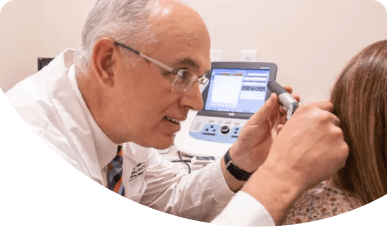Advanced Hearing and Balance Specialists have audiologists providing hearing aid fittings in Utah and South Nevada.
Hearing aid fitting is the crucial process of customizing and adjusting hearing aids to suit an individual’s unique hearing needs. It involves programming the device to amplify sounds effectively while ensuring comfort and optimal performance.
Professional hearing aid fittings are indispensable, as they ensure accurate calibration based on comprehensive hearing assessments, taking into account factors like lifestyle, environment, and specific hearing deficiencies.
Audiologists play a pivotal role in this process, possessing the expertise to fine-tune settings, address concerns, and provide guidance on proper usage and maintenance. Their specialized knowledge ensures that individuals receive tailored solutions, maximizing the benefits of hearing aids and enhancing overall quality of life.
Trusting in professional expertise ensures an effective and personalized approach to hearing aid fitting, promoting greater satisfaction and improved hearing outcomes.
What Happens During a Hearing Aid fitting?
During a hearing aid fitting, several crucial stages ensure that the device is personalized to the individual’s specific hearing needs and preferences.
The process typically involves six main stages:
- Assessment: The audiologist begins by conducting a comprehensive assessment of the individual’s hearing abilities. This may involve various hearing tests to measure hearing thresholds, speech understanding, and other relevant factors.
- Discussion of Lifestyle and Needs: The audiologist discusses the individual’s lifestyle, communication challenges, and specific hearing requirements. Understanding daily activities and environments helps in selecting the most suitable hearing aid features and settings.
- Selection of Hearing Aids: Based on the assessment and lifestyle discussion, the audiologist will recommend hearing aids that best address the individual’s hearing loss and preferences. Factors such as style, technology level, and additional features are considered.
- Customization and Programming: Once the hearing aids are chosen, they are customized and programmed according to the individual’s audiogram and specific needs. The audiologist adjusts settings such as volume, frequency response, and noise reduction to optimize hearing performance.
- Verification: Verification measures are conducted to ensure that the hearing aids are providing the desired amplification and meeting prescribed targets. This may involve real ear measurements or other validation techniques to validate the fitting accuracy.
- Counseling and Training: The audiologist provides counseling on proper hearing aid use, care, and maintenance. They offer guidance on inserting and removing the devices, adjusting settings, and troubleshooting common issues. Additionally, communication strategies and realistic expectations are discussed to maximize the benefits of wearing hearing aids.
Throughout the fitting process, the audiologist works closely with the individual to address any concerns and ensure satisfaction with the chosen hearing aids. Follow-up appointments may be scheduled to monitor progress and make further adjustments if necessary, ensuring optimal hearing outcomes over time.
Real Ear Measurements (REM)
REM is a crucial procedure used during hearing aid fitting to objectively verify and fine-tune the amplification settings of the device according to an individual’s unique ear canal and hearing characteristics. During REM, a tiny microphone probe is placed in the ear canal alongside the hearing aid. The system then measures the actual sound levels produced by the hearing aid inside the ear canal, taking into account factors such as the shape of the ear canal, the placement of the hearing aid, and the individual’s hearing thresholds.
The relevance of REM lies in its ability to ensure that the prescribed amplification matches the specific needs of the individual accurately. By measuring the real sound levels in the ear canal, REM allows audiologists to verify whether the hearing aid is delivering the intended amplification as per the prescription. This verification process is crucial because it helps identify any discrepancies between the prescribed amplification and the actual output of the hearing aid, enabling precise adjustments to be made to optimize hearing aid performance.
REM also plays a vital role in ensuring comfortable and effective amplification while minimizing the risk of overamplification, which can lead to discomfort or further damage to the individual’s hearing. By fine-tuning the settings based on real ear measurements, audiologists can tailor the hearing aid fitting to each individual’s specific hearing needs, improving speech clarity, comfort, and overall satisfaction with the device.
A REM is an essential tool in the hearing aid fitting process, providing objective data to verify and adjust the amplification settings accurately. By incorporating REM into the fitting procedure, audiologists can enhance the effectiveness and comfort of hearing aids, ultimately improving the quality of life for individuals with hearing loss.
Adjusting to Hearing Aids
Adjusting to hearing aids is a process that requires patience and persistence as your brain adapts to processing sounds differently. Initially, wearers may experience a period of adjustment characterized by various sensations:
Sound Amplification
At first, sounds may seem louder or different than before, as hearing aids amplify environmental sounds and speech. This can be overwhelming initially but becomes more natural over time.
Comfort and Fit
Ensuring the hearing aids fit comfortably and securely is essential. It may take some time to get used to the sensation of wearing them, but adjustments can be made by your audiologist to enhance comfort.
Improved Communication
As your brain relearns to process sounds, speech comprehension may improve gradually. However, it is normal to experience some difficulty initially, especially in noisy environments.
The brain plays a crucial role in adjusting to hearing aids. It undergoes a process of relearning to interpret sounds effectively, filtering out background noise, and focusing on speech. Consistent use of hearing aids helps facilitate this relearning process, leading to improved hearing abilities and overall satisfaction with the devices.
With time and practice, most individuals find that their hearing aids become indispensable tools for enhancing communication and quality of life.
Adjustment Period
The adjustment period for new hearing aid users can vary from person to person, but it typically spans a few weeks to a few months. During this time, hearing aid wearers may experience various sensations as they acclimate to their hearing aids.
Here is what to expect during this transition phase:
- Sound Perception: Initially, sounds may seem too loud or different from what you are accustomed to. Your brain needs time to adjust to the amplified sounds.
- Comfort: It may take a while to get used to the feeling of wearing hearing aids in your ears. They should feel comfortable, but it is normal for it to take a little time.
- Improved Communication: With consistent use, speech comprehension should improve, especially in challenging listening environments. However, it may not happen overnight.
Tips for Easing into Daily Use
Transitioning to daily use of hearing aids can be a process. Here are some helpful tips for easing into it:
- Start Slow: Begin by wearing your hearing aids for short periods in quieter environments, gradually increasing the time and exposure to different sounds.
- Be Patient: Give yourself time to adjust. It is okay to feel frustrated or overwhelmed initially but remember that it gets better with practice.
- Practice Listening: Engage in conversations with friends and family members to practice listening with your hearing aids. Consider using a TV or radio at a comfortable volume to help acclimate to different sounds.
Follow-Up Appointments
Follow-up appointments with your audiologist are crucial to ensure your hearing aids are functioning optimally and comfortably.
These appointments allow for:
- Adjustments: Your audiologist can make any necessary adjustments to the settings of your hearing aids based on your feedback and experiences.
- Verification: Real-ear measurements and other verification techniques can confirm that your hearing aids are providing the correct amplification.
- Education: Your audiologist can provide further education on care, maintenance, and optimal use of your hearing aids.
While the adjustment period for new hearing aid users may present challenges, it is a temporary phase that can be eased with patience, practice, and support from your audiologist through follow-up appointments.
Hearing Aid Fitting FAQs
Are hearing aid fittings covered by insurance?
The coverage for hearing aid fittings depends on your insurance plan. While some insurance policies may cover part or all of the cost, others may not offer coverage. It is essential to review your insurance policy or contact your provider to understand the extent of coverage for hearing aid fittings. Keep in mind that coverage may vary based on factors such as the type of insurance plan you have and any specific requirements or limitations outlined in your policy.
How can I make my hearing aid fit better?
To improve the fit of your hearing aid, consider the following steps:
- Consult with Your Audiologist: Your audiologist can assess the fit of your hearing aid and make necessary adjustments to ensure it sits comfortably and securely in your ear.
- Consider Ear Molds: Custom ear molds can provide a more precise fit for your hearing aid, reducing the likelihood of slippage or discomfort.
- Try Different Ear Tips: If you use behind-the-ear (BTE) or receiver-in-canal (RIC) hearing aids, experimenting with different ear tips or domes can help find the best fit for your ear canal shape and size.
- Keep Your Ears Clean: Proper ear hygiene is essential to maintain a good fit. Clean your ears regularly to prevent wax buildup, which can affect the fit and performance of your hearing aid.
- Use Retention Clips or Hooks: Retention clips or hooks can help secure behind-the-ear hearing aids in place, particularly during physical activities or if you have an active lifestyle.
- Consider Professional Assistance: If you are having persistent issues with the fit of your hearing aid, consult with your audiologist for further adjustments or recommendations.
By following these tips and working closely with your audiologist, you can ensure that your hearing aid fits better and provides optimal comfort and performance.
How long does it take for a hearing aid to be fitted?
The time it takes to fit a hearing aid can vary depending on several factors, including the complexity of the individual’s hearing loss, the type of hearing aid being fitted, and any additional adjustments required.
Typically, the initial fitting appointment may last around 1 to 2 hours. During this time, the audiologist will conduct assessments, discuss lifestyle and hearing needs, select the appropriate hearing aid, customize and program it, and provide guidance on usage and maintenance.
Follow-up appointments may be necessary to fine-tune the settings and ensure optimal performance, which can extend the fitting process over several weeks or months.
Hearing Aid Fittings in Utah and South Nevada | Advanced Hearing & Balance Specialists
At Advanced Hearing & Balance Specialists, our hearing aid fitting services are tailored to meet your unique needs, ensuring optimal hearing enhancement and comfort.
Take the first step toward better hearing health by scheduling your hearing aid fitting with Advanced Hearing & Balance Specialists today.
With clinics conveniently located across Utah and Nevada, including St. George, Cedar City, Murray, Hurricane, Beaver, Panguitch, Mesquite, and Overton, expert hearing care is closer than you think.
Contact us today to schedule an appointment with expert audiologists in Nevada and Utah!




